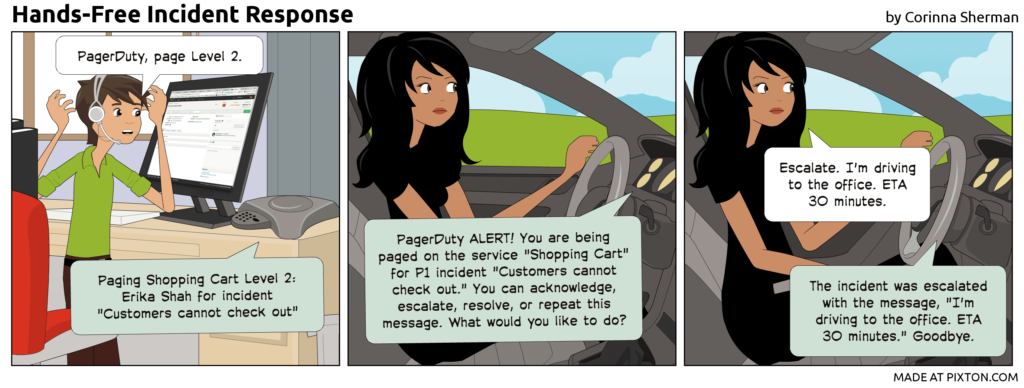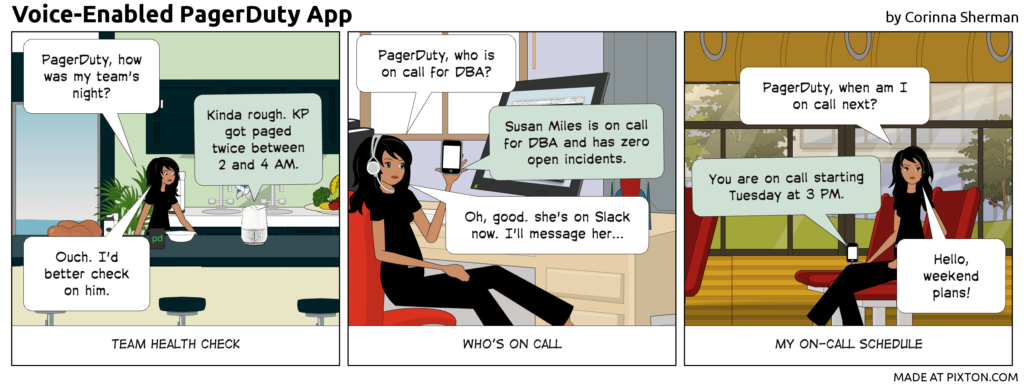Okay, Google. When Am I On-Call Next?
Is VoiceOps Ready for the Next Step?
Imagine this: PagerDuty calls and a calm voice tells you that you have problems to pay attention to. Your internal response is perhaps not as calm and sounds something like this:
“Aahh! I have to fix this!”
“How should I fix this?”
“Is this someone else’s problem? Can this be someone else’s problem?”
Or some expletive I can’t publish here.
The reality is that the rising DevOps movement means that responders aren’t limited to just solving problems from 9 to 5 in a cubicle. Smartphones, laptops, and fast home Wi-Fi enable and occasionally require people to do their work from home. When something comes up, they can be notified and respond anywhere, anytime, and through a number of platforms.
But even with today’s technology-forward society and myriad communication options, there are times when people can’t or don’t have access to a laptop and reliable Wi-Fi: commuting, meeting someone for coffee, getting a root canal at the dentist’s office. In these cases, responding with their voice can feel more natural (ok, except for the root canal):
“Escalate. I can’t answer right now.”
“Yeah, okay. Acknowledge.”
“Hmm. Request additional responder. Find Ellen from the database team.”

With this scenario in mind, a few of us at PagerDuty started researching how people might like to actually talk to PagerDuty. First, we considered the two situations people associate the most with PagerDuty:
War Time: A number of people are responding to a major incident, most likely with multiple teams involved and communicating on a conference bridge.
Skirmish Time: One responder is acknowledging and dealing with a minor incident, probably working alone and referencing some dashboards, metrics, and runbooks to resolve the issue.
But there’s another scenario: Peace Time. This is when teams make the most of the relative quiet to edit schedules, check analytics, configure services, and manage overrides. Consider how people gained trust with voice-enabled devices at home. Most of these interactions are relatively “peaceful.” Consumers have started trusting voice-enabled devices around their homes by experimenting with relatively non-urgent commands:
“Do I need an umbrella today?
“Tell me a joke.”
“How fast can cheetahs run?”
Checking on the state of a system should be just as natural as checking the weather. VoiceOps in a peacetime scenario can transform the way people manage their digital operations. Corinna Sherman, a UX designer, and Zayna Shahzad, a lead software engineer, and I mapped out the possibilities of VoiceOps for peacetime, then built a prototype using Google Assistant, a Google Home device, and the PagerDuty API.

We then teamed up with the Actions on Google development community and hosted a joint hack event last month, where we shared the prototype with the PagerDuty Community and attendees from Hackbright Academy and Code2040.
During the event, everyone brainstormed to come up with ideas and build demos using Actions on Google Assistant and PagerDuty APIs. Winners were awarded Google Home devices so they could continue working on their projects after the event. Additionally, Ido Green, Dev Evangelist for Actions on Google, helped participants understand the principles of designing for voice, walked through some code labs, and shared how Dialogflow adapts and trains using different natural language techniques to improve over time.
https://www.slideshare.net/greenido/vui-design?ref=https://greenido.wordpress.com/
What did we learn?
- VoiceOps is promising for responders during Skirmish Time scenarios when responders are working on their own to resolve minor incidents.
- VoiceOps has promise for managers in Peace Time, providing answers to people who do not usually check their team’s PagerDuty application every day.
- VoiceOps is not ready yet for War Time just yet: As Corinna points out, voice recognition can still be pretty spotty when it comes to recognizing accents or when the speaker is in a room with questionable acoustics.
People will use VoiceOps if voice recognition and interaction work—and work well. If any voice interaction doesn’t work as designed, then people will get frustrated and stop trusting it.
Want to learn more? Check out the prototype and join the discussion in the community forum. What would you ask when you’re on call? When you’re not? We’d love to hear it. Also, don’t forget to join the PagerDuty Community to stay up-to-date on events and more!


